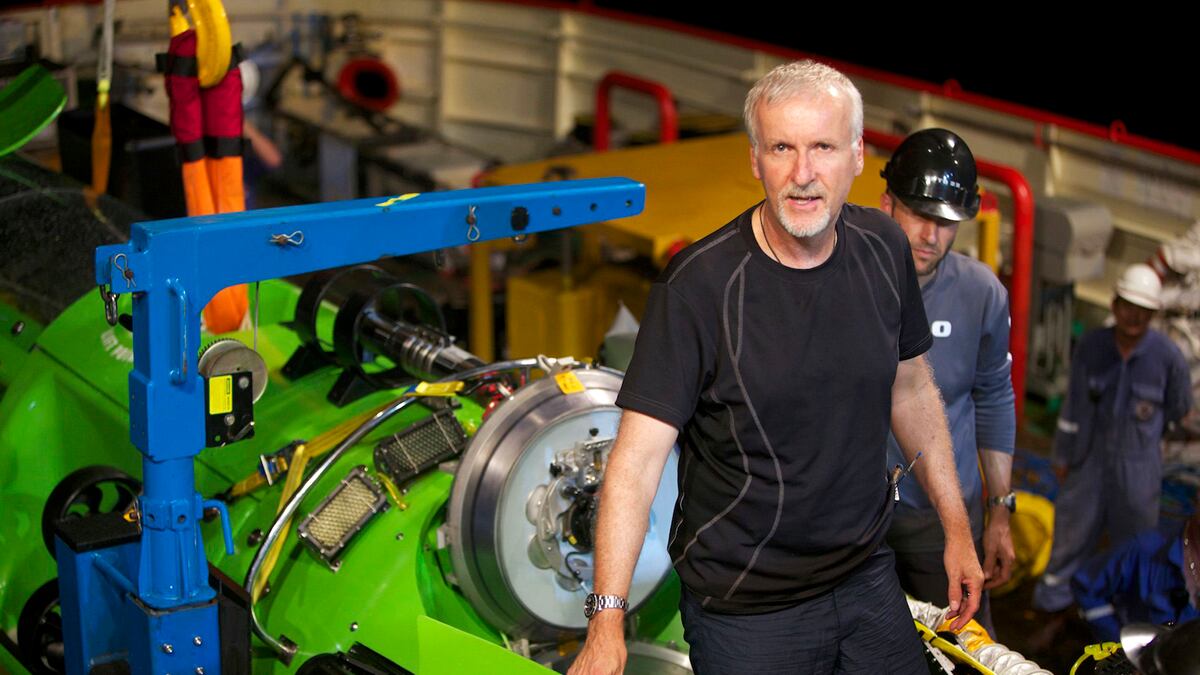It took U.S. Navy Lt. Don Walsh four hours and 48 minutes to sink through the abyss to the deepest known point on the planet, an ocean underworld so forbidding that it is likened to Hades’ kingdom and so extreme that it has the power to literally dissolve a human body.
He had slipped into the water earlier that day relatively unknown outside the military circles in which he moved, but surfaced as a hero along with his crewmate, Swiss oceanographer and engineer Jacques Piccard, having accomplished a feat so epic that no one has repeated it in the 52 years that have passed since.
Now 80, Walsh is back in the Pacific once more for a replay of one of the greatest achievements in human exploration. This time, however, he is staying strictly topside.
ADVERTISEMENT
Instead it is James Cameron—Hollywood film director, science enthusiast, and explorer extraordinaire—who will seek to make the death-defying journey seven miles below the surface of the earth to the point known as Challenger Deep, located in the Mariana Trench, 62 miles southwest of Guam.
If all goes well, the Canadian filmmaker hopes before the end of this week to become the first person to journey solo to the bottom of the world, squeezed into a compartment just 43 inches (109cms) wide at the nose end of an 11.8-ton submersible named Deepsea Challenger.
It will be the ultimate adventure for a man whose curiosity for the deep was first fired as a schoolboy, drove production of screen spectaculars such as The Abyss and Titanic, and led him to spend thousands of hours over the years roving the seas in submersibles. But it will also be the ultimate risk.
“When you’re making a movie, everybody’s read the script and they know what’s going to happen next. When you’re on an expedition, nature hasn’t read the script, the ocean hasn’t read the script and no one knows what’s going to happen next,” Cameron, 57, acknowledged in a video posted to his expedition website.
Despite dominating Challenger Deep’s history for more than half a century, Walsh—whose partner aboard the Trieste on Jan. 23, 1960, died four years ago—has no problem with the prospect of Cameron joining him in the record books. And as one of the 60-strong team of ocean experts Cameron has assembled around himself aboard the mothership, Mermaid Sapphire, Walsh believes in the mission as more than just a stunt.
“If he does it, which I believe he will, I couldn’t be more proud,” says Walsh, who also worked as a technical adviser on Cameron’s 1989 underwater sci-fi extravaganza The Abyss, and on his expeditions to the wrecks of the Titanic and the German World War II battleship Bismarck.
Speaking from his home in Oregon before flying to Guam to join Cameron last week, he adds:
“The ocean needs more people like Jim. He wants to make what will arguably be the world’s greatest documentary, and it will be compelling.
“How many people fell in love with the ocean when they started seeing [Jacques] Cousteau’s films? It affected a whole generation. Well, I liken Jim to Cousteau on steroids.”

Deepsea Challenger—codesigned by Cameron, pricetag unknown—has been eight years in the making. It carries lights and eight specially-built cameras, including IMAX and 3-D capabilities, which will allow him to record his journey and ultimately share it with the wider world. Its exterior electronics comprise more than 1,500 circuit boards. Its body is made up of syntactic foam, a composite material that will shrink by 2.5 inches during the dive, due to the crushing water pressure of 16,000 pounds per square inch at the bottom—akin to 8,000 elephants standing on a Mini Cooper car.
The 36,070 foot descent to Challenger Deep will take less than two hours and the ascent one hour. Space restrictions mean Cameron’s legs will be tightly bent, his arms barely able to move. “There’s just enough room in there for him and his ego,” quipped one associate of the reputedly difficult-to-work-with movie king.
Cameron has been practicing yoga to help train his 6-foot-2 body for the ordeal, and free-diving to increase his lung capacity and, therefore, his body’s oxygen efficiency.
Whereas the purpose of Walsh and Piccard’s dive was simply to prove that it could be done (they spent 20 minutes on the bottom eating chocolate), Cameron plans six hours exploring and taking biological and geological samples using robotic tools. Scientists from the Scripps Institution of Oceanography in San Diego, NASA, and the University of Hawaii are among the expedition’s partners, along with National Geographic and Rolex.
Around 2 percent of the planet’s sea expanse plumbs depths in excess of 20,000 feet—a delineation known as the Hadal zone, named after Hades, the ancient Greek god of the underworld. Cameron refers to it as “the last frontier of exploration here on Planet Earth.”
Whereas scientists once believed that life could not exist at such massive depths, investigations have shown otherwise. Walsh and Piccard believe they saw fish on the bottom. A Japanese robotic probe in 1995 found shrimp and worms. A Scripps team who sent cameras and lights into the trench last year, spotted jellyfish and xenophyophores—gigantic single-celled amoebae—living deeper than they have ever been found before.
Understanding how they survive at such extremes is considered key to unlocking mysteries of the Earth’s past and protecting the oceans’ future, as well as exploring its biotechnological potential. Could unknown medical cures exist down there? scientists ask. Is the environment changing? How can it be protected?
“A sense of wonder and possibility have always accompanied exploration of the deepest ocean depths,” says Kevin Hardy, a senior development engineer at Scripps. “The sea is already providing dietary supplements for health, and cures for human conditions as diverse as osteoporosis, heart disease, and even cancer.”
He adds: “Trench fauna are some of the most ancient forms of life we know. Sheltered from many of the causes of cellular mutations found topside, these living creatures provide us a glimpse into the earliest life of this planet, a starting point for evolution, and clues to finding life elsewhere in our solar system and beyond.”
Commercial manufacturers are already working on a new generation of submersibles capable of opening up areas such as the Mariana Trench to future fare-paying tourists with a yearning for the deep.
In Vero Beach, Fla., engineers at Triton Submarines (motto: “We’re going to bring the ocean to the world”) have designed a $17 million, three-person vehicle that they envision one day operating passenger trips to Challenger Deep for $250,000 a ticket, seated in a roomy pressure-chamber with 360-degree visibility.
Triton’s bosses—one of whom, president Patrick Lahey, piloted deep rovers for Cameron’s 2005 underwater documentary Aliens of the Deep—say that the public’s appetite for adventure outweighs its appetite for science. Bringing people face to face with the excitement of the ocean, firsthand or through film, will bring a greater empathy for its preservation, says vice president Marc Deppe.
“Guys centuries ago didn’t go exploring for new lands because they thought, ‘Let’s find some new lands.’ They did it because they thought they’d find some really cool s--t,” he says. “That’s what inspires people—they fall in love with the adventure and the mystery and they want to know more.”
A test dive by Cameron 26,791 feet to the bottom of the New Britain Trench, east of Papua New Guinea, earlier this month set a record for the deepest ever solo dive. A battery failure caused one of the sub’s 12 thrusters to lose power, along with some communications capabilities, but he surfaced safely.
“Sitting down there at 27,000 feet, alone in the dark, with no comms, no contact whatsoever with the world so far above, and nothing but the ingenuity of the engineering to get me back … it’s simultaneously scary and exhilarating,” he wrote afterwards in an email to Walsh.
“It’s the precipice we put ourselves on by choice, to test ourselves and our machines,” he added, signing off: “You’d have loved it.”






